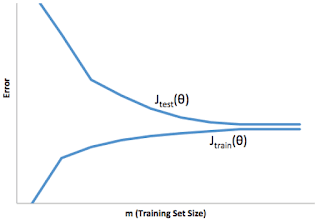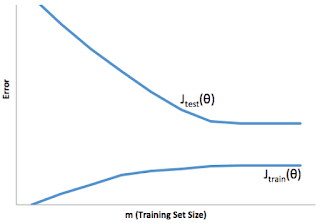Coursera: Machine Learning (Week 6) Quiz - Advice for Applying Machine Learning | Andrew NG
Recommended Courses:
1.Advice for Applying Machine Learning.
Don't just copy & paste for the sake of completion. The solutions uploaded here are only for reference.They are meant to unblock you if you get stuck somewhere.Make sure you understand first.
- You train a learning algorithm, and find that it has unacceptably high error on the test set. You plot the learning curve, and obtain the figure below. Is the algorithm suffering from high bias, high variance, or neither?
- High variance
- Neither
- High bias
- You train a learning algorithm, and find that it has unacceptably high error on the test set. You plot the learning curve, and obtain the figure below. Is the algorithm suffering from high bias, high variance, or neither?
- High variance
- Neither
- High bias
- Suppose you have implemented regularized logistic regression to classify what object is in an image (i.e., to do object recognition). However, when you test your hypothesis on a new set of images, you find that it makes unacceptably large errors with its predictions on the new images. However, your hypothesis performs well (has low error) on the training set. Which of the following are promising steps to take? Check all that apply.
NOTE: Since the hypothesis performs well (has low error) on the training set, it is suffering from high variance (overfitting)- Try adding polynomial features.
- Use fewer training examples.
- Try using a smaller set of features.
- Get more training examples.
- Try evaluating the hypothesis on a cross validation set rather than the test set.
- Try decreasing the regularization parameter λ.
- Try increasing the regularization parameter λ.
- Suppose you have implemented regularized logistic regression to predict what items customers will purchase on a web shopping site. However, when you test your hypothesis on a new set of customers, you find that it makes unacceptably large errors in its predictions. Furthermore, the hypothesis performs poorly on the training set. Which of the following might be promising steps to take? Check all that apply.
NOTE: Since the hypothesis performs poorly on the training set, it is suffering from high bias (underfitting)- Try increasing the regularization parameter λ.
- Try decreasing the regularization parameter λ..
- Try evaluating the hypothesis on a cross validation set rather than the test set.
- Use fewer training examples.
- Try adding polynomial features.
- Try using a smaller set of features.
- Try to obtain and use additional features.
- Which of the following statements are true? Check all that apply.
- Suppose you are training a regularized linear regression model. The recommended way to choose what value of regularization parameter to use is to choose the value of which gives the lowest test set error.
- Suppose you are training a regularized linear regression model.The recommended way to choose what value of regularization parameter to use is to choose the value of which gives the lowest training set error.
- The performance of a learning algorithm on the training set will typically be better than its performance on the test set.
- Suppose you are training a regularized linear regression model. The recommended way to choose what value of regularization parameter to use is to choose the value of which gives the lowest cross validation error.
- A typical split of a dataset into training, validation and test sets might be 60% training set, 20% validation set, and 20% test set.
- Suppose you are training a logistic regression classifier using polynomial features and want to select what degree polynomial (denoted in the lecture videos) to use. After training the classifier on the entire training set, you decide to use a subset of the training examples as a validation set. This will work just as well as having a validation set that is separate (disjoint) from the training set.
- It is okay to use data from the test set to choose the regularization parameter λ, but not the model parameters (θ).
- Suppose you are using linear regression to predict housing prices, and your dataset comes sorted in order of increasing sizes of houses. It is then important to randomly shuffle the dataset before splitting it into training, validation and test sets, so that we don’t have all the smallest houses going into the training set, and all the largest houses going into the test set.
- 5.Which of the following statements are true? Check all that apply.
- A model with more parameters is more prone to overfitting and typically has higher variance.
- If the training and test errors are about the same, adding more features will not help improve the results.
- If a learning algorithm is suffering from high bias, only adding more training examples may not improve the test error significantly.
- If a learning algorithm is suffering from high variance, adding more training examples is likely to improve the test error.
- When debugging learning algorithms, it is useful to plot a learning curve to understand if there is a high bias or high variance problem.
- If a neural network has much lower training error than test error, then adding more layers will help bring the test error down because we can fit the test set better.
- 一一一一一一一一一一一一一一一一一一一一一一一一一一一一一一一一一一一一一一一
&Have no concerns to ask doubts in the comment section. I will give my best to answer it.If you find this helpful kindly comment and share the post.This is the simplest way to encourage me to keep doing such work.Thanks & Regards,- Wolf




Comments
Post a Comment